A bird bath led to the discovery of the poetry of birds
Last year, my wife decided she wanted a bird bath in the kitchen garden. She found one she liked, of concrete construction and simple in design. Our two sons helped move the bowl and pedestal from the car to the garden. It looks light—deceptively light; I can barely manage to empty the bowl when I clean it.
I named it “The Ce-ment Pond,” in honor of one of my favorite childhood television shows, The Beverly Hillbillies. It has become an avian gathering place, a community center, a source of water in the St. Louis summer heat, and a communal bathtub.
It’s also a source of discord. The birds fight over it.
Our regular visitors are Mr. and Mrs. Cardinal, Mr. and Mrs. Mourning Dove, a pair of house finches (whose name I’ve Anglicized to the House-Finches), a pair of goldfinches who are small but win the color sweepstakes, Mr. and Mrs. Sparrow, and Mr. Blue Jay, who shows up occasionally to scold the others. But if one pair of visitors rules, it’s Mr. and Mrs. Robin. I was surprised; I didn’t realize that robins could be so territorial and aggressive in chasing the others away, even the blue jay. Only the House-Finches will brave the wrath of the Robins who, surprisingly, usually leave them alone.
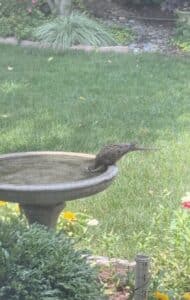
A mourning dove at The Ce-Ment Pond
That is, unless the House-Finches interrupt Mrs. Robin’s bath, which happens four or five times a day. Then she bullies them away. Only Mr. Robin is allowed to perch on the ledge if she’s of a mind to bathe.
They’re all on the skittish side. They’ll suffer my presence through the glass of the screened kitchen windows, as long as I don’t get too close. If they spot me slowly raising my mobile for a photo, they’re gone.
However, they do recognize me. I’m the guy who cleans the pond, every two days. If I forget, they will land on the ledge of the bird bath, sniff, and then stare at me, as if waiting for the man with the plastic brush to do what he’s ordained to do. I add water every morning; the Robins in particular have a habit of taking splash baths, knocking a good portion of the water over the side.
Not long ago, while watching this community of birds with their daily antics around The Ce-ment Pond, I realized that was I was watching poetry in motion. They can suddenly swoop in, or off, with great grace. They will sit motionless, watching the water, or perhaps their own reflections, for a considerable period, before either daintily taking a sip or cannonballing into the water. And you never know which action they’ll take.
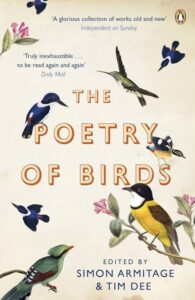
We have Coleridge and his albatross, Chaucer and his parliament of fowls, Marianne Moore and her ostrich, Yeats and his wild swans, Whitman and his eagles, Gerard Manley Hopkins and his kestrel, Sylvia Plath and her pheasant, Emily Dickinson and her oriole, and even D.H. Lawrence writing about turkeys. Elizabeth Bishop liked sandpipers, Keats has his nightingale (he also had a dove, which died), Wordsworth has his cuckoo (he wasn’t all daffodils), Thomas Hardy wrote about skylarks, Ted Hughes about crows, and Elizabeth Barrett Browning wrote an ode to swallows (among other subjects).
That doesn’t even scratch the surface. And don’t forget the most famous bird of all—Edgar Allan Poe’s raven, inspired by a pet kept by the family of Charles Dickens. And I learned that I’m not the only person who’s given the birds proper names: Edward Lear wrote a poem about “Mr. and Mrs. Spikky Sparrow.”
Poets write about what birds do and what they are. They sing. They fly (most of them, anyway). They have their own language (so says Coleridge). They serenade each other. They die. They build nests (obviously). They bathe. (Boy, do they bathe. Especially robins.)
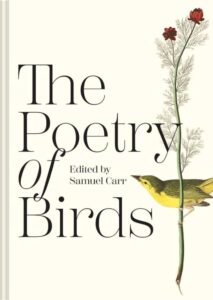
My quest to find the poetry of birds led me to two collections, both with the same name (both were first published in Britain, which may tell you something about the British and birds). In 2012, British poet laureate Simon Armitage published The Poetry of Birds, nicely organized by the names of birds. The table of contents is 13 pages long, if that’s any indication of the popularity of birds as muses for poets. (And it doesn’t include “The Raven”!)
The second collection, also entitled The Poetry of Birds, was edited by Samuel Carr and published in 2023. It’s a flat-out beautiful little book, bordering on the gorgeous. It has fewer poems than the Armitage volume, but almost every poem is illustrated by a lavish painting by John James Audubon. While many of the poems are about specific birds, many are also thematic about birds in general.
Accompanied by an Audubon painting, here is Thomas Hardy:
I Watched a Blackbird

Audubon’s blackbirds
I watched a blackbird on a budding sycamore
One Easter Day, when sap was stirring twigs to the core;
I saw his tongue, and crocus-colored bill
Parting and closing as he turned his trill;
Then he flew down seized on a stem of hay,
And upped to where his building scheme was under way,
As if so sure a nest were never shaped on spray.
Before the installation of The Ce-ment Pond, I didn’t consider myself a birdwatcher. Now, I can sit or stand for long periods, mobile in hand and Google at the ready to identify birds I don’t recognize (which is often most of them, but I’m learning). I worry about the first frost, when the pond will be emptied, cleaned, and covered for the winter. My wife even considered adding a bird feeder, but I said The Ce-ment Pond custodian drew the line there; he would not clean up after the birds at feeding time.
But for now I watch, occasionally pull off a photo (including the window screen), and think about writing a poem that would start “I learned it’s always good for a laugh / to watch the birds zoom in for a bath.” Well, maybe not.
Related
Mourning Doves – poem by Paulette Calasibetta at Society of Classical Poets
Photo by jimpg2_2015, Creative Commons, via Flickr. Post by Glynn Young.
How to Read a Poem uses images like the mouse, the hive, the switch (from the Billy Collins poem)—to guide readers into new ways of understanding poems. Anthology included.
“I require all our incoming poetry students—in the MFA I direct—to buy and read this book.”
—Jeanetta Calhoun Mish
- Poet Sidney Lanier and the Lost Cause - October 2, 2025
- Poets and Poems: A.J. Thibault and “We Lack a Word” - September 30, 2025
- Poets and Poems: Catherine Strisik and “Goat, Goddess, Moon” - September 25, 2025
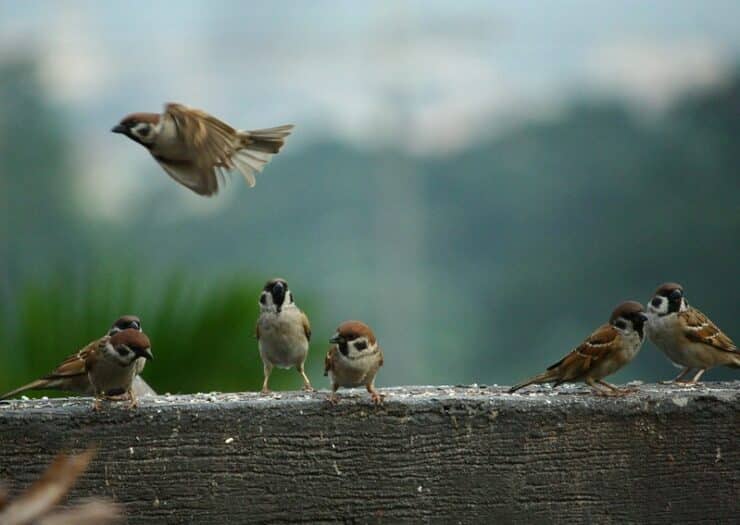
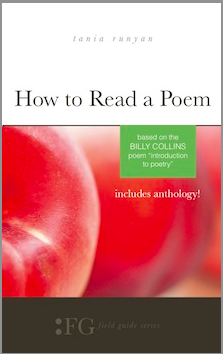
L.L. Barkat says
Delightful post, Glynn. Thanks for giving me a smile! 🙂 (Those birds have now extended their bath-antics reach!)
Laura Boggess says
Oh, Glynn, this is just delightful. You had me at bird. If your nice to me, I won’t tell Janet about the heated bird baths that enable cement pond bathing all winter long…
Glynn says
Heated ce-ment ponds? Nooooooooo! It would have me out there in the middle of winter cleaning up after the birds every two days.
The birds, especially the robins, maintain a calendar for cleaning the birdbath. If I miss a day, the robins will sit out there in the grass, staring at our kitchen window, until I get the message, get my plastic brush and a bucket of water.